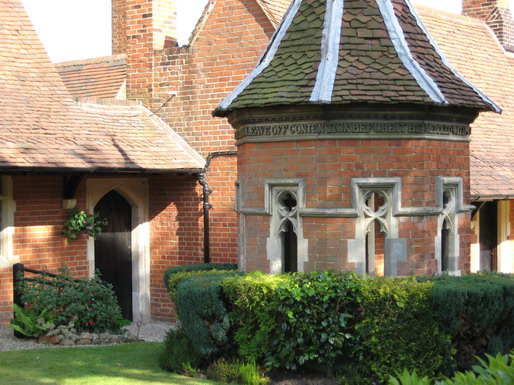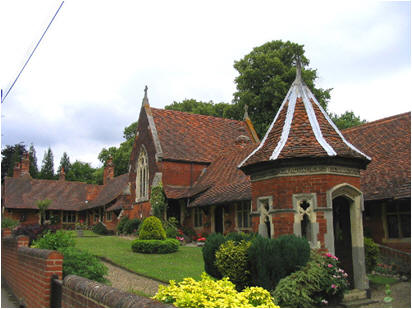A promising young lawyer named Anthony Browne bought the manor of South Weald in 1548 and moved into the house in the park called Weald Hall (demolished 1950). Religious heretics were causing unrest around the country and many of these he prosecuted so successfully that he was made Chief Justice of the Common Pleas. In trying to ensure a good education for his son (a privilege of the wealthy), he set up a school on Brook Street hill in 1558. A few years later it was moved into the town and is now known as Brentwood School. In 1563 Anthony and his wife Joan drafted a deed conveying to the master and wardens of Brentwood School three cottages containing five dwellings in South Weald, the residents to be nominated by the tenant of South Weald manor. These almshouses were to be maintained out of Brentwood School’s endowments, but the deed was not executed and so void in law. Knighted in 1566, Sir Anthony provided in his will, for the management in accordance with that draft deed. He died in 1567 in retirement at Weald Hall (the top of his tomb can be seen in the Memorial Chapel at St. Peter’s Church). Two of the almshouses appear to have been opposite Weald Hall and the other three in Wigley Bush Lane.
The manor of South Weald passed through his descendants until sold in 1668 to Sir William Scroggs, the Lord Chief Justice. In 1685 his son sold it to Erasmus Smith whose heirs enjoyed it until 1752 when Thomas Tower of Iver, Bucks, bought it. He rebuilt three of the almshouses in the 1770’s. The estate expanded under the Towers, and in 1851 Christopher J. H. Tower obtained an Act of Parliament to build ten almshouses. They were built in 1854 to the design off S.S. Teulon, with a central chapel and well-head building, in Elizabethan style as you see them today. The foundation stone laid by Lady Sophie Tower is, strangely, in the back of the Chapel, but the opening date is repeated at the bottom of the stained glass window seen inside.
It is difficult to imagine today how important that well-head building, with its biblical quotation around the top, must have been to the residents; particularly as piped water did not reach the almshouses until the 1920’s. Electricity came soon after, but was only used for lighting initially. In 1968 Sir Anthony Browne’s Almshouse Charity was combined with the Charity of William Wingrave (1909) and with a loan from Brentwood Council and a bequest from Catherine Deltour, two adjacent almshouses were built in similar style on land given by C. T. Tower. Central heating was eventually added to all twelve almhouses from oil-fired boilers until gas mains were laid to the village in 1989, allowing the boilers to be converted to the more convenient fuel.
Although the Tower family sold the Weald Hall estate in 1946 (now Weald Park), they maintained an interest through the present Trustees. There is also a link with the unexecuted deed of 1563, in that Brentwood School provides a representative on the trustee board and the school makes an annual donation to the running costs
The improvement project had been some years in the planning when work started in June 1993. The backs of the ten older houses were extended to give them each a modern kitchen and bathroom. New kitchen and bathroom equipment has been installed in the 1968 pair and all have been substantially repaired and upgraded to modern standards.
Interesting features are the figures standing in the gable ends of numbers 1 and 10. The gentleman in the former has been repaired, but the lady, believed to be Queen Elizabeth I, was badly eroded and beyond repair. The Trustees are indebted to the Dean and Chapter of Westminster Abbey for permitting the small replica of a proposed life-size statue of Queen Elizabeth I to be displayed there now.


